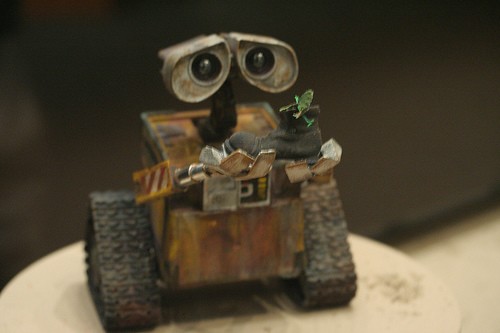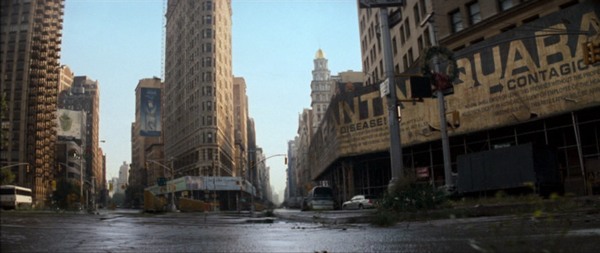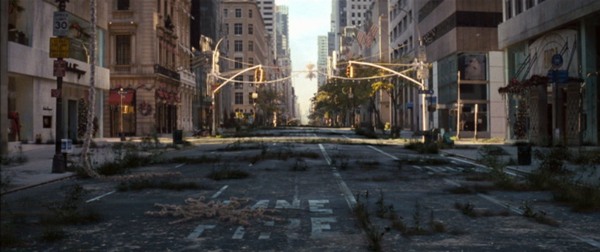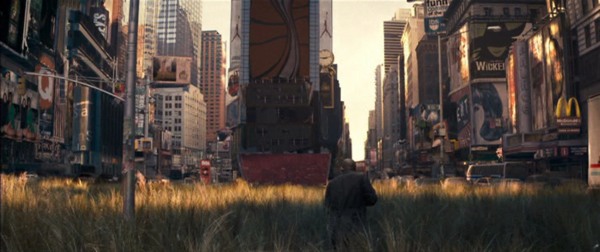Not much to add to the critical consensus around WALL-E; trusted voices such as Tim Burke’s, as well as the distributed hive mind of Rotten Tomatoes, agree that it’s great. Having seen the movie yesterday (a full two days after its release, which feels like an eternity by the clockspeed of media blogging), I concur — and leave as given my praise for its instantly empathetic characters, striking environments, and balletic storytelling. It’s the first time in a while that tears have welled in my eyes just at the beautiful precision of the choices being made 24 times per second up on the big screen; a happy recognition that Pixar, over and over, is somehow nailing it at both the fine level of frame generation and the macro levels of marketplace logic and movie history. We are in the midst of a classic run.
Building on my comments on Tim’s post, I’m intrigued by the trick Pixar has pulled off in positioning itself amid such turbulent crosscurrents of technological change and cinematic evolution: rapids aboil with mixed feelings about nostalgia for golden age versus the need to stay new and fresh. The movies’ mental market share — the grip in which the cinematic medium holds our collective imaginary — is premised on an essential contradiction between the pleasures of the familiar and the equally strong draw of the unfamiliar. That dialectic is visible in every mainstream movie as a tension between the predictability of genre patterns and the discrete deformations we systematize and label as style.
But nowadays this split has taken on a new visibility, even a certain urgency, as we confront a cinema that seems suddenly digital to its roots. Hemingway (or maybe it was Fitzgerald) wrote that people who go bankrupt do so twice: first gradually, then all at once. The same seems true of computer technology’s encroachment on traditional filmmaking practices. We thought it was creeping up on us, but in a seeming eyeblink, it’s everywhere. Bouncing around inside the noisy carnival of the summer movie season, careening from the waxy simulacrum of Indiana Jones into the glutinous candied nightmare of Speed Racer, it’s easy to feel we’re waking up the morning after an alien invasion, to find ourselves lying in bed with an uncanny synthetic replacement of our spouse.
Pixar’s great and subtle achievement is that it makes the digital/cinema pod-people scenario seem like a simple case of Capgras Syndrome, a fleeting patch of paranoia in which we peer suspiciously at our movies and fail to recognize them as being the same lovable old thing as always. With its unbroken track record of releases celebrated for their “heart,” Pixar is marking out a strategy for the successful future of a fully digital cinema. The irony, of course, is that the studio is doing so by shrugging off its own cutting-edge nature, making high-tech products with low-tech content.
Which is not to say that WALL-E lacks in technological sublimity. On the contrary, it’s a ringing hymn to what machines can do, both in front of and behind the camera. More so than the plastic bobbles of Toy Story, the chitinous carapaces of A Bug’s Life, the scales and fins of Finding Nemo or the polished chassis of Cars, the performers in WALL-E capture the fundamental gadgety wonder of a CG character: they look like little robots, but in another, more inclusive sense they are robots — cyborged 2D sandwiches of actors’ voices, animators’ keyframes, and procedural rendering. There’s a longstanding trope in Pixar films that the coldly inorganic can be brought to life; think of the wooden effigy of a bird built by the heroes of A Bug’s Life, or the existential yearnings of Woody and Buzz Lightyear in the Toy Story films. WALL-E, however, calibrates a much narrower metaphorical gap between its subject matter and its underlying mode of production. Its sweetly comic drama of machines whose preprogrammed functionalities are indistinguishable from their lifeforce is like a reassuring parable of cinema’s future: whether the originating matrix is silicon or celluloid, our virtual pleasures will reflect (even enshrine) an enduring humanity.
I’ll forgo commentary on the story and its rich webwork of themes, except to note a felicitous convergence of technology’s hetero gendering and competing design aesthetics that remap the Macintosh’s white curves onto the eggy life-incubator of EVE — juxtaposed with a masculine counterpart in the ugly-handsome boxiness of PC and LINUX worlds. I delighted in the film’s vision of an interstellar cruise liner populated by placid chubbies, but was also impressed by the opening 30-40 minutes set amid the ruins of civilization. It says something that for the second time this year, a mainstream science-fiction film has enticed us to imagine ourselves the lone survivor of a decimated earth, portraying this situation on one level as a prison of loneliness and on another as an extended vacation: tourists of the apocalypse. I refer here of course to the better-than-expected I Am Legend, whose vistas of a plague-depopulated Manhattan unfold in loving extended takes that invite Bazinian immersion and contemplation:
Beyond these observations, what stands out to me among the many pleasures of WALL-E are the bumper materials on either side of the feature: the short “Presto,” which precedes the main film, and the credit sequence that closes the show. Such paratexts are always meaningful in a Pixar production, but tend to receive less commentary than the “meat” of the movie. Tim points out accurately that “Presto” is the first time a Pixar short has captured the antic Dionysian spirit of a Tex Avery cartoon (though I’d add that Avery’s signature eruption of the id, that curvaceous caricature of womanhood Red, was preemptively foregrounded by Jessica Rabbit in 1988’s Who Framed Roger Rabbit; such sex-doll humor seems unlikely to be emulated any time soon in Pixar’s family-friendly universe — though the Wolf could conceivably make an appearance). What I like about “Presto” is the short’s reliance on “portal logic” — the manifold possibilities for physical comedy and agonistic drama in the phenomenon of spatial bilocation, so smartly operationalized in the Valve videogame Portal.
As for the end credits of WALL-E, they are unexpectedly daring in scope, recapitulating the history of illustration itself — compressing thousands of years of representational practices in a span of minutes. As the first names appear onscreen, cave drawings coalesce, revealing what happens as robots and humans work together to repopulate the earth and nurse its ecosystem back to health. The cave drawings give way to Egyptian-style hieroglyphs and profiled 2D portraiture, Renaissance perspective drawings, a succession of painterly styles. Daring, then subversive: from Seurat’s pointillism, Monet’s impressionism, and Van Gogh’s loony swirls, the credits leap to 8-bit computer graphics circa the early 1980s — around the time, as told in David A. Price’s enjoyable history of the studio, that Pixar itself came into existence. WALL-E and his friends cavort in the form of jagged sprites, the same as you’d find in any Atari 2600 game, or perhaps remediated on the tiny screens of cell phones or the Wii’s retrographics.
I’m not sure what WALL-E‘s credits are “saying” with all this, but surely it provides a clue to the larger logic of technological succession as it is being subtextually narrated by Pixar. Note, for example, that photography as a medium appears nowhere in the credits’ graphic roll call; more scandalously, neither does cinematography — nor animation. In Pixar’s restaging of its own primal scene, the digital emerges from another tradition entirely: one more ludic, more subjective and individualistic, more of an “art.” Like all ideologies, the argument is both transparently graspable and fathoms deep. Cautionary tale, recuperative fantasy, manufactured history doubling as road map for an uncertain digital future: Pixar’s movies, none more so than WALL-E, put it all over at once.





You know what I liked about the animation in the end credits? It was a great reminder that ultimately, above all else, the geniuses at Pixar are amazing storytellers. Yes, the are animation effects wizards (in ways that are, I’m sure, mostly invisible to me) but they also, at the end of the day, tell an excellent story. I didn’t tear up at the end of the movie because it was so gorgeous to look at it (though it was) but because they had told me a story that made me care about a 700 year old robot, so much so that when that same robot is rendered in 80s style 8-bit computer graphics and does little but dart back and forth across the screen, I’m still riveted
I agree! I loved the film’s affectionate invocation of 8-bit graphics; in preparation for a future post, I’ve been making a list of my favorite computer games, many of which were from that era.
I might be a little late to continue discussion on “Wall-E”. I thought it was a great point, one that didn’t once occur to me while watching the movie, that the story of “Wall-E” so closely parallels Pixar’s unique brand of infusing technology with soul and goodwill, in unquestionably granting its robot characters a “life force” as you say. Unlike the wave of digital paranoia that came with “The Matrix” there isn’t nearly as clear cut a dichotomy between the analog and the digital. I found your point about the omission of photography and film in the end credits chronology really curious, especially since “Wall-E” seems to be one of the more photorealistic Pixar films. Elvis Mitchell has an interview with Andrew Stanton on his radio show in which Stanton relates an interesting story about the production of “Wall-E” at around 19:00 that shows the great lengths to which he went to keep “Wall-E” as cinematic-looking as possible, camera imperfections and all. Perhaps allowing photography and film a place in the lineage of visual arts would have been a little too meta for what is ultimately an simple, old school story.
Thanks for the link, Alex. I watched WALL-E again this weekend and noticed a lot more of the jiggly camerawork and pulled focus that announces itself as “actual” cinematography rather than virtual camerawork. (Heck, every time we see a lens flare in a Pixar film, it’s in emulation of an older technology.)
Regarding the omission of photography and cinematography from the end credits, I like your explanation — it’s got an Occam’s-razor quality to it. But I still feel that Pixar has got something on its institutional “mind” that comes out symptomatically in its films … we may have to wait until several decades have passed to diagnose it clearly. Hope I’m still around to blog about it!